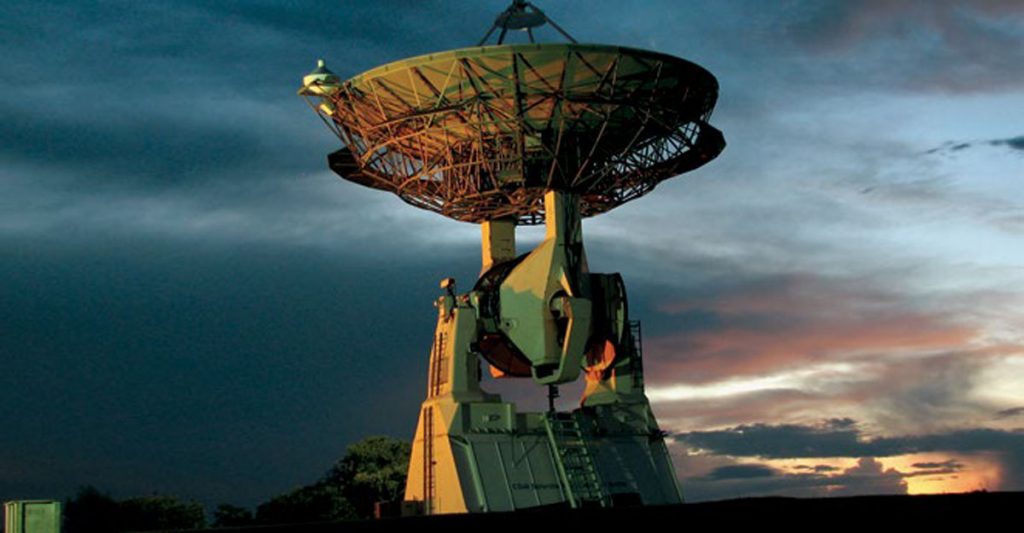
Facilities
Explore all of SANSA's facilities. Double-left-click to zoom the map in and double-right-click to zoom the map out.Space Science
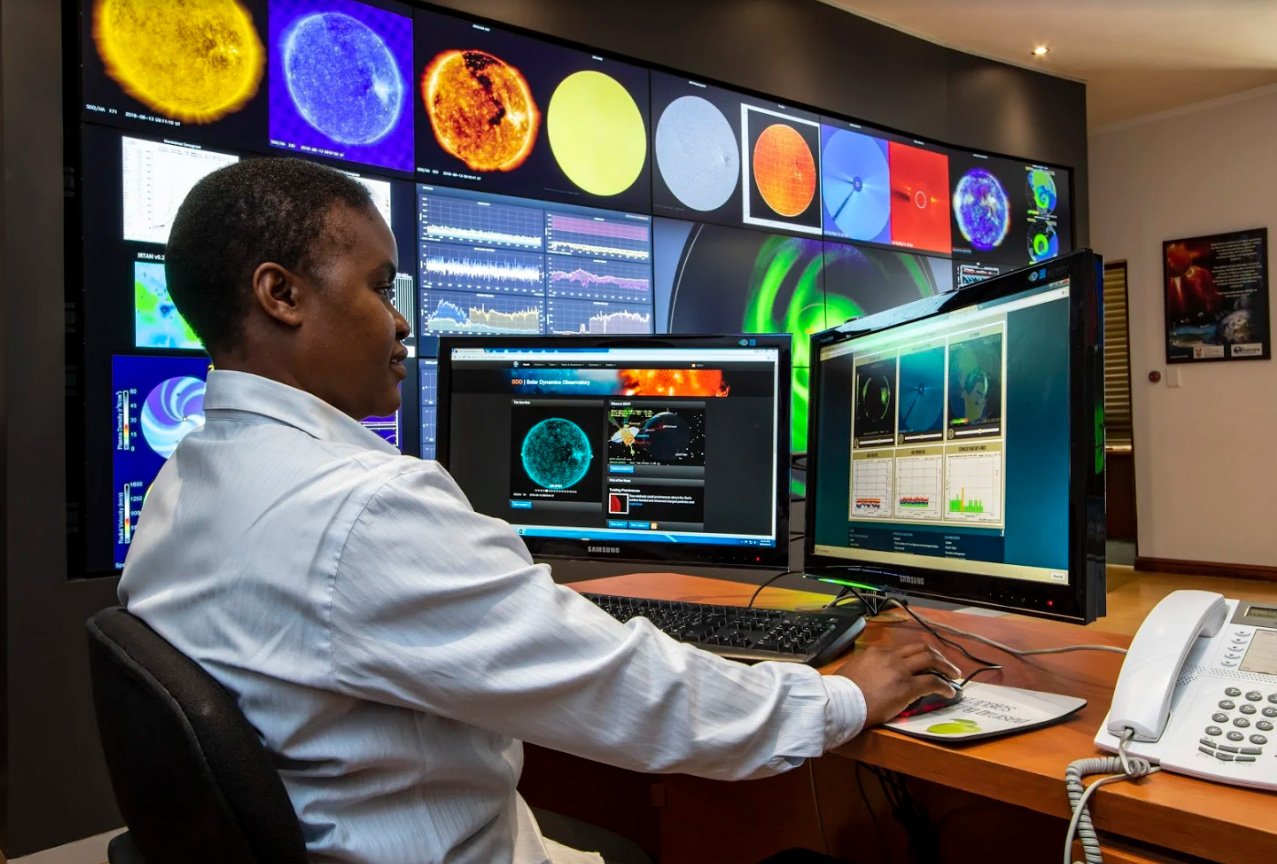 SANSA is host to the only Space Weather Regional Warning Centre in Africa, which operates as part of the International Space Environment Service (ISES). SANSA’s Space Weather Centre provides an important service to the nation by monitoring the Sun and its activity, and by providing space weather forecasts, warnings, alerts, and environmental data on space weather conditions.
SANSA is host to the only Space Weather Regional Warning Centre in Africa, which operates as part of the International Space Environment Service (ISES). SANSA’s Space Weather Centre provides an important service to the nation by monitoring the Sun and its activity, and by providing space weather forecasts, warnings, alerts, and environmental data on space weather conditions.
Space weather products and services are required primarily for communication and navigation systems in the defence, aeronautics, navigation and communication sectors. The Space Weather Centre offers products and services to both the general public and clients.
Magnetically Clean Facility
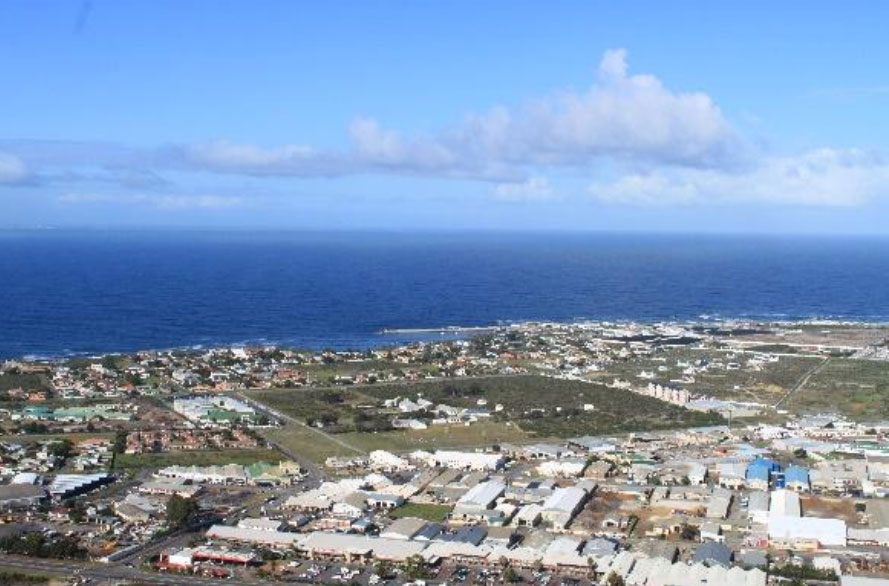 SANSA operates a magnetically clean environment within its facility at Hermanus. The facility has operated as a magnetic observatory since 1940.
SANSA operates a magnetically clean environment within its facility at Hermanus. The facility has operated as a magnetic observatory since 1940.
SANSA’s facilities in Hermanus are equipped to characterise and calibrate magnetic sensors, or identify the magnetic signature of dynamic platforms such as satellites and UAVs prior to sensor integration. With over 80 years’ experience in quality magnetic information for research, applications, products and services, SANSA is internationally recognised as a world-class facility for magnetic technology and applications.
A magnetically clean environment can only be achieved in locations away from the typical magnetic disturbances found in cities, such as DC (direct current) electrical railway lines, and in an area where no large magnetic gradients occur due to magnetised rock formations below the surface. The construction of buildings within a magnetic observatory must be non-magnetic in nature, and the type of activity conducted within the observatory requires an understanding of the impact on the environment.
SANSA operates the below state-of-the-art equipment and infrastructure at the Hermanus facility, situated within a 16 ha buffer area against DC and low-frequency magnetic disturbances:
- Large 2.5 m tri-axial Helmholtz Coil system used to evaluate and calibrate various magnetic sensors and systems
- Zero-field (≤ 10 nT) magnetic shielding chamber for magnetic evaluation of sensors
- Non-magnetic temperature chamber (-45°C to +70°C) for functional temperature evaluation of magnetic sensors and other equipment
- High temperature Superconducting Quantum Interference Device (SQUID) for the recording of very faint geomagnetic signals
- A magnetically clean compass swing area for trials and training
- Highly sensitive scalar and vector research-grade magnetometers for the measurement and evaluation of magnetic environments
In addition, experts at the facility have the geomagnetic expertise needed to derive accurate baseline measurements, crucial for providing a magnetic baseline on which most applications can be built. The facility also develops bi-annual geomagnetic field maps that contribute towards navigation and positioning applications within Africa.
Helmholtz Coil
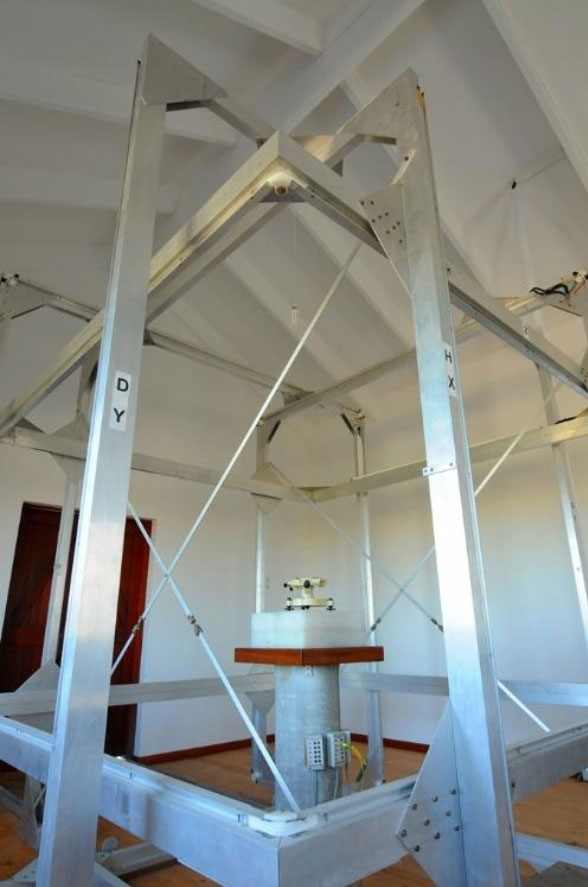 SANSA is host to the only large tri-axial Helmholtz Coil system in Africa, which is available to clients and external institutions. The coil system can be used to create or cancel any geomagnetic field, and is controlled to cancel the local geomagnetic field in real time. This system is used to evaluate and calibrate various magnetic sensors and magnetic systems. The system has a 2.5 m side length; fields of up to 100 000 nT can be generated in three axes at a resolution of about 3 nT; and the homogeneous area in the centre of the coil system, where the uniformity is 0.01%, is an oval form with a length of approximately 25 cm.
SANSA is host to the only large tri-axial Helmholtz Coil system in Africa, which is available to clients and external institutions. The coil system can be used to create or cancel any geomagnetic field, and is controlled to cancel the local geomagnetic field in real time. This system is used to evaluate and calibrate various magnetic sensors and magnetic systems. The system has a 2.5 m side length; fields of up to 100 000 nT can be generated in three axes at a resolution of about 3 nT; and the homogeneous area in the centre of the coil system, where the uniformity is 0.01%, is an oval form with a length of approximately 25 cm.
Temperature Chamber
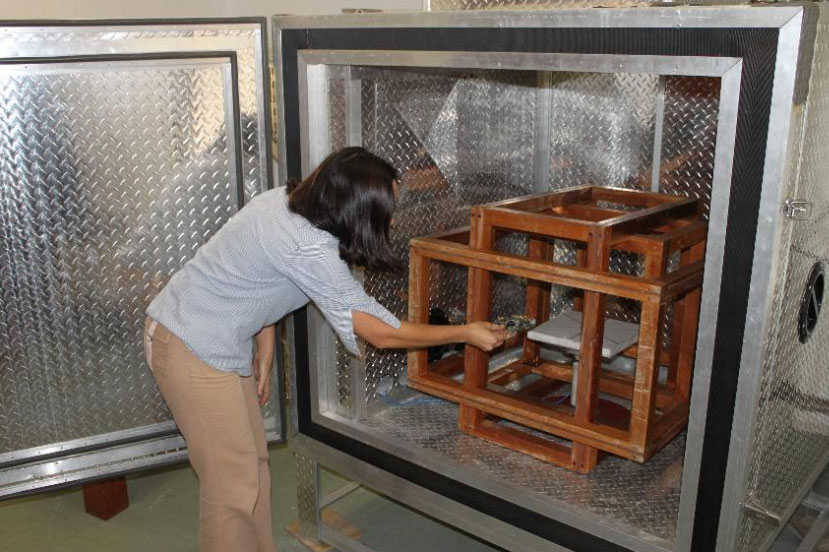
SANSA exposes devices such as satellite components to extreme heat (70 degrees Celsius) and extreme cold (minus 45 degrees Celsius) to stimulate conditions that devices are exposed to in space. This is essential in order to test satellite components for their journey in space. SANSA is the leader in non-magnetic temperature evaluations of satellite components in southern Africa.
Non-magnetic Screening Chamber
SANSA operates a non-magnetic screening chamber to determine electronic offsets of magnetometers. The screening chamber provides magnetic screening of 20 000 x in the radial direction and 2 000 x in the longitudinal direction.
Absolute House
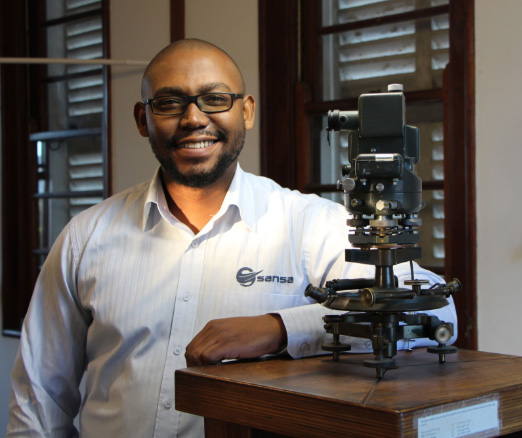 Magnetic reference directions and deviations from true North in southern Africa are measured at SANSA’s Absolute House. These observations are used to calibrate continuous electronic magnetic field measurements, and any variation in electronic instruments is compensated for absolute magnetic measurements taken in the Absolute House. These differences are used in a database of magnetic field changes to allow accurate calibration of compasses and magnetometers for navigation.
Magnetic reference directions and deviations from true North in southern Africa are measured at SANSA’s Absolute House. These observations are used to calibrate continuous electronic magnetic field measurements, and any variation in electronic instruments is compensated for absolute magnetic measurements taken in the Absolute House. These differences are used in a database of magnetic field changes to allow accurate calibration of compasses and magnetometers for navigation.
Superconducting Quantum Interference Device (SQUID)
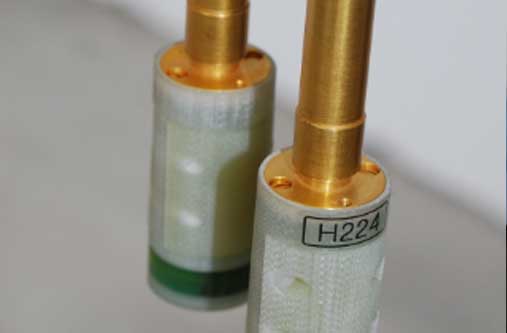 The SQUID forms part of a global network of SQUID sensors to measure and predict adverse space weather and other magnetic phenomena, specifically focussing on the magnetic signatures of seismic precursors. The first node of this network is a Low Temperature SQUID which has been operating for the past 10 years from a low-noise underground laboratory in France at Laboratoire Souterrain à Bas Bruit (LSBB).
The SQUID forms part of a global network of SQUID sensors to measure and predict adverse space weather and other magnetic phenomena, specifically focussing on the magnetic signatures of seismic precursors. The first node of this network is a Low Temperature SQUID which has been operating for the past 10 years from a low-noise underground laboratory in France at Laboratoire Souterrain à Bas Bruit (LSBB).
The two-axis High Temperature SQUID is located at SANSA in Hermanus in a specialised non-magnetic building located in a magnetically quiet environment that adheres to Magnetic Observatory standards. The SQUID magnetometer consists of one horizontal sensor and one vertical sensor; both are M2700 High-Tc dc SQUID sensors from StarCryo, and are operated completely unshielded in the geomagnetic field. The SANSA SQUID magnetometer is inserted into a non-magnetic dewar with liquid Nitrogen and cooled to the operating temperature of 77 Kelvin.
Science Centre & Mobile Space Lab
SANSA promotes awareness and interest in Science, Technology, Engineering and Maths (STEM) among learners, educators, the general public and policy-makers through a long-standing and successful Science Engagement Programme. Most activities are hosted within the SANSA Science Centre and from the SANSA Space Lab, a state-of-the-art interactive mobile laboratory. The activities are specifically aimed at educators and learners with an emphasis on practical learning programmes.

Tours
If you would like to find out more about the SANSA facility in Hermanus please join the team for a fascinating tour of the Space Agency. The tour is free of charge and takes place every Wednesday from 11:00 – 12:00.
Please note that the Public Tours have been suspended under the current level 4 lockdown regulations.
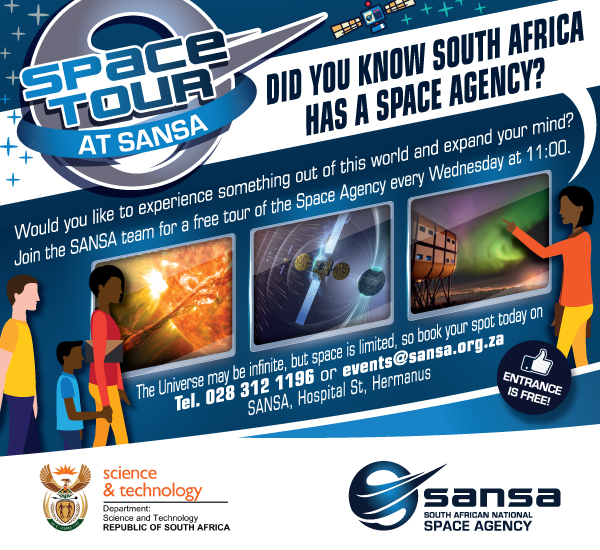
Earth Observation
For more information about Earth Observation products and services, contact customers-eo@sansa.org.za
Space Operations
Overview of Space Operations
The SANSA Space Operations programme specialises a wide range of space mission support services. With over 60 years of experience in TT&C support, which started with NASA and JPL in the early 1960s and continues to be one of the most sort after ground station in the world to this day. As a “ground station of choice”,SANSA boasts a wide range of TT&C ground segment capabilities and establishments from may intenational space agencies and satellite operators across the globe.
This SANSA facility is perfectly positioned geographically, on a remote farm in Hartebeeshoek as a centre for Tracking, Telemetry and Command (TT&C) for geo-synchronous, polar orbiting and scientific spacecraft. The facility operates antenna systems in the S,C,X,Ku bands and uses state-of-the-art communication and reliable power distribution.
The TT&C capabilities of the staff and facilities at Hartebeesthoek enables the station to support any ground segment requirements, from establishing high-tech ground facilities such as antennas and ground stations, to operation and maintenance of such facilities for international clients.
Location
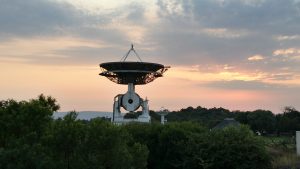 SANSA is nestled in a quiet and remote area of the Magaliesburg mountain range at 1553m ASL and in an area called Hartebeesthoek. The area provides an extremely good horizon mask for tracking low-orbit satellites. The site is located approximately 60km west of Pretoria and 40km north of Johannesburg. The physical position of the site is Latitude 25° 53′ South, Longitude 27° 42′ East.
SANSA is nestled in a quiet and remote area of the Magaliesburg mountain range at 1553m ASL and in an area called Hartebeesthoek. The area provides an extremely good horizon mask for tracking low-orbit satellites. The site is located approximately 60km west of Pretoria and 40km north of Johannesburg. The physical position of the site is Latitude 25° 53′ South, Longitude 27° 42′ East.
The site is situated in a benign environmental location with no significant seismic activity having ever been detected at the location of the SO. The area is not subject to severe winds or other natural threats such as earthquakes.
A new site to support deep space missions launched in Matjiesfontien (MTJ) in 2022 and will support missions such as the NASA Artemis missions that aim to take humans back to the moon by December 2025.
Products & Services
Hartebeesthoek antennas:
HBK-2: S-and Ext C-band antenna
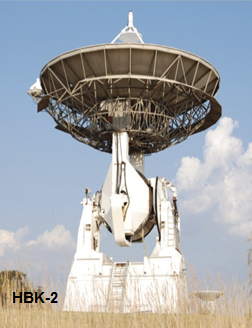
HBK-2: S-and Ext C-band antenna
HBK-2 Slew rate: 10°/sec
Dish diameter: 12m
Tracking mode: Program and Autotrack
Polarisation: LCP and RCP
Transmit 1
Frequency range: 6.8 – 7.2 GHz
EIRP: 88dBW Receive
Frequency range: 2.2 – 2.4 GHz
G/T: 22.4 dB/°K
Acquisition Aid ant: 1.07m 2.2 – 2.3 GHz only
Transmit 2
Frequency range: 2.025 – 2.15 GHz
EIRP: 69dBW
HBK-5: S, X-band antenna
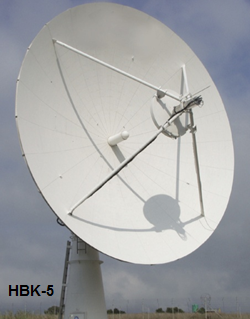
HBK-5: S, X-band antenna
HBK-5 Slew rate: 10°/sec
Dish diameter: 10m
Tracking mode: Program and Autotrack
Polarisation: LCP and RCP Receive
Frequency range:
Rx1: 2.2 – 2.4 GHz [G/T: 22.4 dB/°K]
Rx2: 8.0 – 8.5 GHz [G/T: 31.0 dB/°K]
Transmit
Frequency range: 2.025 – 2.10 GHz
EIRP: 65dBW
HBK-7: Ku/DBS-band antenna
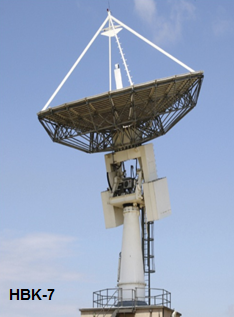
HBK-7: Ku/DBS-band antenna
HBK-7 Slew rate: 2°/sec
Dish diameter: 13.2m
Tracking mode: Program and Autotrack
Polarisation: Circular and Linear
Receive
Frequency range: 10.95 – 12.75 GHz
G/T: 38.25 dB/°K (@12.75 GHz) Transmit
Frequency range:
Tx1: 12.75 – 14.5 GHz
Tx2: 17.3 – 18.1 GHz
EIRP:
91dBW (@12.75 GHz)
92.6dBW (@17.5 GHz)
HBK-8: Ka-band antenna
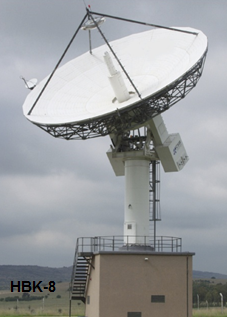
HBK-8: Ka-band antenna
HBK-8 Slew rate: 2°/sec
Dish diameter: 13.2m
Tracking mode: Program and Autotrack
Polarisation: LCP and RCP
Transmit 1
Frequency range: 29.5 – 30.0 GHz
EIRP: 92dBW Receive
Frequency range: 17.7 – 21.2 GHz
G/T: 41.8 dB/°K
Transmit 2
Frequency range: 27.5 – 31.0 GHz
EIRP: 87dBW
MO-1: S-band mobile antenna
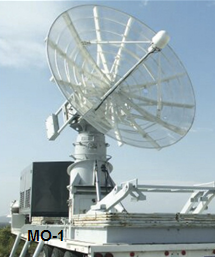
MO-1: S-band mobile antenna
MO-1 Slew rate: 20°/sec
Dish diameter: 15ft
Tracking mode: Program and Autotrack
Polarisation: LCP and RCP
Receive
Frequency range: Rx1: 2.2 – 2.4 GHz
G/T: Rx1: 11.6 dB/°K
HBK-9: X-band antenna
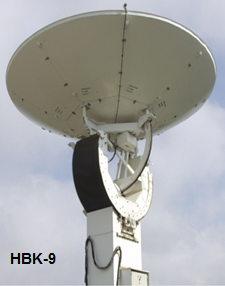
HBK-9: X-band antenna
HBK-9 Slew rate: 3°/sec
Dish diameter: 5.4m
Tracking mode: Program and Autotrack
Polarisation: RCP
Receive
Frequency range: 8.0 – 8.5 GHz
G/T: 30.5 dB/°K
HBK-10: C-band (designated Pre-15T by Intelsat) antenna
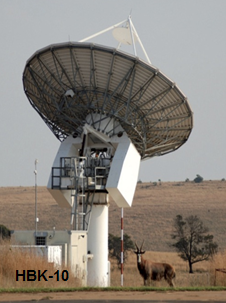
HBK-10: C-band (designated Pre-15T by Intelsat) antenna
HBK-10 Slew rate: 5°/sec Amzimuth, 1.4°/sec Elevation
Dish diameter: 11m
Tracking mode: Program and Autotrack
Polarisation: Circular
Receive
Frequency range: 3.625 – 4.2 GHz
G/T: 31.7 dB/°K
HBK-16: X-band antenna
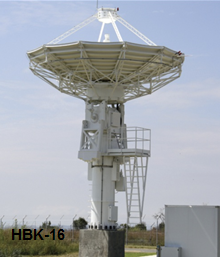
HBK-16: X-band antenna
HBK-16 Slew rate: 3°/sec
Dish diameter: 7.3m
Tracking mode: Program and Autotrack
Polarisation: LCP and RCP
Receive
Frequency range: 8.0 – 8.5 GHz
HBK-17: Ku-band antenna
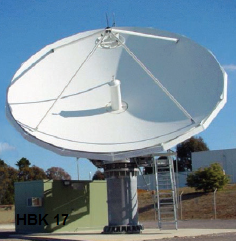
HBK-17: Ku-band antenna
Dish diameter: 9m
Tracking mode: Program and Autotrack
Polarisation: Linear and Circular
Receive
Frequency range: 10.95 – 12.75 GHz
G/T: 35 dB/°K
SANSA Space Science
Hermanus, South Africa
SANSA Space Science: 028 312 1196
Hospital Street
Hermanus
7200
Western Cape
South Africa
SANSA Space Operations
Hartebeesthoek, South Africa
SANSA Space Operations: 012 334 5000
Farm No 502 JQ
Hartebeesthoek
District Krugersdorp
Gauteng
South Africa
SANSA Head Office, Earth Observation & Space Engineering
Pretoria, South Africa
SANSA Head Office: 012 844 0500
Enterprise Building
Mark Shuttleworth Street
Innovation Hub
Pretoria 0087
Gauteng
South Africa
HBK-2

HBK-2: S-and Ext C-band antenna
HBK-2 Slew rate: 10°/sec
Dish diameter: 12m
Tracking mode: Program and Autotrack
Polarisation: LCP and RCP
Transmit 1
Frequency range: 6.8 – 7.2 GHz
EIRP: 88dBW Receive
Frequency range: 2.2 – 2.4 GHz
G/T: 22.4 dB/°K
Acquisition Aid ant: 1.07m 2.2 – 2.3 GHz only
Transmit 2
Frequency range: 2.025 – 2.15 GHz
EIRP: 69dBW
HBK-5

HBK-5: S, X-band antenna
HBK-5 Slew rate: 10°/sec
Dish diameter: 10m
Tracking mode: Program and Autotrack
Polarisation: LCP and RCP Receive
Frequency range:
Rx1: 2.2 – 2.4 GHz [G/T: 22.4 dB/°K]
Rx2: 8.0 – 8.5 GHz [G/T: 31.0 dB/°K]
Transmit
Frequency range: 2.025 – 2.10 GHz
EIRP: 65dBW
HBK-7

HBK-7: Ku/DBS-band antenna
HBK-7 Slew rate: 2°/sec
Dish diameter: 13.2m
Tracking mode: Program and Autotrack
Polarisation: Circular and Linear
Receive
Frequency range: 10.95 – 12.75 GHz
G/T: 38.25 dB/°K (@12.75 GHz) Transmit
Frequency range:
Tx1: 12.75 – 14.5 GHz
Tx2: 17.3 – 18.1 GHz
EIRP:
91dBW (@12.75 GHz)
92.6dBW (@17.5 GHz)
HBK-8

HBK-8: Ka-band antenna
HBK-8 Slew rate: 2°/sec
Dish diameter: 13.2m
Tracking mode: Program and Autotrack
Polarisation: LCP and RCP
Transmit 1
Frequency range: 29.5 – 30.0 GHz
EIRP: 92dBW Receive
Frequency range: 17.7 – 21.2 GHz
G/T: 41.8 dB/°K
Transmit 2
Frequency range: 27.5 – 31.0 GHz
EIRP: 87dBW
MO-1

MO-1: S-band mobile antenna
MO-1 Slew rate: 20°/sec
Dish diameter: 15ft
Tracking mode: Program and Autotrack
Polarisation: LCP and RCP
Receive
Frequency range: Rx1: 2.2 – 2.4 GHz
G/T: Rx1: 11.6 dB/°K
HBK-17

HBK-17: Ku-band antenna
Dish diameter: 9m
Tracking mode: Program and Autotrack
Polarisation: Linear and Circular
Receive
Frequency range: 10.95 – 12.75 GHz
G/T: 35 dB/°K
HBK-16

HBK-16: X-band antenna
HBK-16 Slew rate: 3°/sec
Dish diameter: 7.3m
Tracking mode: Program and Autotrack
Polarisation: LCP and RCP
Receive
Frequency range: 8.0 – 8.5 GHz
HBK-10

HBK-10: C-band (designated Pre-15T by Intelsat) antenna
HBK-10 Slew rate: 5°/sec Amzimuth, 1.4°/sec Elevation
Dish diameter: 11m
Tracking mode: Program and Autotrack
Polarisation: Circular
Receive
Frequency range: 3.625 – 4.2 GHz
G/T: 31.7 dB/°K
HBK-9

HBK-9: X-band antenna
HBK-9 Slew rate: 3°/sec
Dish diameter: 5.4m
Tracking mode: Program and Autotrack
Polarisation: RCP
Receive
Frequency range: 8.0 – 8.5 GHz
G/T: 30.5 dB/°K




